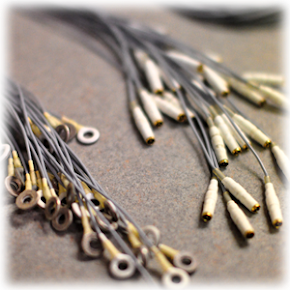
Electroencephalography (EEG) is the recording of electrical activity along the scalp. EEG measures voltage fluctuations at various locations on the scalp resulting from current flows within the neurons of the brain. In the Different Minds Lab, we use a 64-channel QuickAmp Brain Vision system to collect EEG data. The advantage of EEG is its high temporal resolution. In our current system, the temporal resolution can be as high as 1000Hz, meaning that we can collect data every 1/1000 of a second. However, the disadvantage of EEG is its poor spatial resolution. It is mathematically impossible to find the exact source of the brain activity based on scalp-level EEG. However, combined with previous knowledge of the source of the brain activity related to the task being performed, and the various source localization methods, we can at least have a good estimate of the source of the signal.

We examine both event-related potentials (ERP) and the steady-state visually-evoked potentials (SSVEP). ERPs elicited by a specific event in one of the sensory channels (e.g., visual, auditory) provides information of how strong (amplitude) and fast (latency) a certain brain response is, and can be averaged across a lot of trials and then compared across different conditions (e.g., the visual presentation of an upright vs. an inverted face) in terms of the amplitude and latency of the peaks. By contrast, SSVEPs are evoked by periodic visual stimulation. For example, if you are watching the presentation of faces at 6Hz (6 faces per second), neural responses will be entrained into 6Hz and its harmonics (i.e, 12 Hz, 18Hz, 24Hz, etc.). We investigate the strength of the frequency component in the brain wave corresponding to the stimulation frequency across different conditions. For example, if the power of the 6 Hz component in the brain wave is stronger when you are looking at upright faces flickering at 6 Hz, then when you are looking at inverted faces flickering at 6 Hz.
